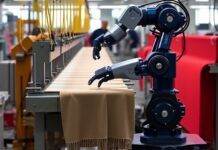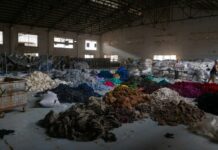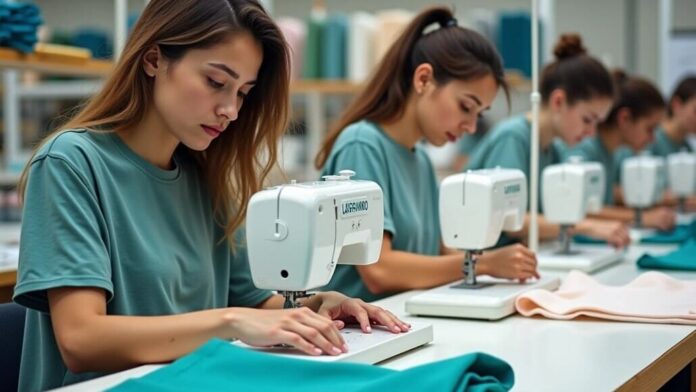The idea of “Made in America” has long been romanticized as a hallmark of quality, patriotism, and economic empowerment. Former President Trump’s “America First” trade policy sought to restore American manufacturing by encouraging the reshoring of jobs, particularly in the fashion industry. However, despite political efforts and public interest in supporting domestic production, the dream of a thriving American fashion manufacturing sector remains largely unattainable. Limited resources, high operational costs, and global competition have created significant barriers to achieving this ideal.
Industry Context
In the mid-20th century, the United States was a global leader in apparel manufacturing. However, the late 20th century saw a mass exodus of textile production to countries like China, Vietnam, and Bangladesh, where labor was cheaper and regulations less stringent. The “Made in America” label nearly disappeared as brands moved production offshore to maintain competitiveness in a fast-fashion-driven market.
Reshoring, or bringing production back to the U.S., became a central tenet of Trump’s administration. Speaking on the plan, Trump emphasized, “We will bring back our jobs. We will bring back our factories. And we will make America great again.” While this rhetoric rekindled hopes for a domestic manufacturing revival, the reality has been far more complex.
Challenges in Domestic Fashion Production
- High Costs of Production
The cost of manufacturing in the U.S. is significantly higher than in most textile-producing countries. American workers earn higher wages, and stringent labor laws mandate benefits such as health insurance and paid leave. According to industry observers, the cost of producing a T-shirt in the U.S. could be as much as three to four times higher than producing the same garment in Bangladesh. Mitch Gambert, an executive in the fashion sector, recently stated, “Domestic production is noble in theory, but the price point becomes unsustainable for brands catering to cost-conscious consumers.” - Infrastructure Gaps
The U.S. manufacturing ecosystem is no longer equipped to handle large-scale textile production. Many textile mills were shuttered decades ago, and skilled labor in this field has declined significantly. Revitalizing this sector would require massive investments in infrastructure, training, and technology. Without a robust supply chain, reliance on imported raw materials further diminishes the benefits of producing garments domestically. - Global Supply Chain Dependencies
The interconnected global economy has made fashion production a highly specialized process. Even with domestic manufacturing, components such as fabric, zippers, and labels are often sourced internationally. This reliance complicates the notion of 100% “Made in America” products. Additionally, global supply chain disruptions during the COVID-19 pandemic exposed the vulnerabilities of dependency on offshore suppliers.
Sustainability as a Driving Force
While cost concerns dominate conversations about domestic production, sustainability has emerged as a strong secondary motivator. Many consumers are willing to pay a premium for ethical and eco-friendly products, creating opportunities for American brands to capitalize on slow fashion trends. Local production reduces carbon emissions associated with long transport routes, aligning with sustainability goals. Yet, the scalability of such initiatives remains questionable.
Recent Innovations and Technology
Technological advancements like automation and 3D printing have been heralded as solutions to make American manufacturing more viable. Automation can reduce labor requirements, thereby lowering costs. For instance, U.S.-based companies have begun experimenting with robotic sewing machines to improve productivity. In addition, innovations in recycled textiles and circular fashion models are being leveraged by companies looking to lead the charge in sustainable manufacturing. However, critics argue that these technologies are still in their infancy and not yet cost-effective at scale.
Consumer Behavior and Market Trends
Consumer interest in “Made in America” products is growing but remains a niche market. Surveys indicate that while many Americans claim they value domestically made goods, their purchasing decisions are overwhelmingly influenced by price. The success of brands like Allbirds and American Giant demonstrates that a market does exist for premium products emphasizing U.S. production, but these brands cater primarily to affluent consumers who can afford the higher price tags.
Key Stakeholders and Their Roles
Beyond government policy, the private sector must play a significant role in reshaping the domestic manufacturing landscape. Larger corporations with the financial resources to invest in reshoring initiatives could lead by example. Startups offering innovative solutions, such as on-demand manufacturing, can also make an impact. Meanwhile, collaboration between educational institutions and the industry is essential in training the next generation of skilled laborers.
Looking Ahead
Despite formidable challenges, the dream of “Made in America” in fashion is not entirely unattainable. Moving forward, government incentives like tax breaks and grants could help offset the high costs of domestic production. Partnerships between brands, manufacturers, and technology providers could spur innovation and efficiency.
The future of American manufacturing may not resemble its industrial past, but a hybrid model—where select product lines are produced domestically while others are fabricated abroad—could strike a balance between cost and localization.
Conclusion
While the dream of “Made in America” remains elusive in the fashion industry, it is not without promise. Challenges such as high costs, infrastructure gaps, and global dependencies require innovative solutions and collective effort. Consumer demand for ethically produced goods and advancements in technology offer a glimmer of hope. As the industry evolves, the question is not whether “Made in America” can become a reality, but how it can adapt to meet modern expectations of sustainability, efficiency, and affordability.


































